How to Form and Choose a Chord Progression?
How to select the right chords and chord progressions for a song? That’s a thinker, especially if you have no understanding of music theory. If you don’t know which chords go together, it’s kind of hard to start composing.
I suggest that you read my post about “How to Understand Chords and Keys” first and then come back to this one. Read it already? Great, you can skip the next chapter and go straight to “How to Form Chord Progressions?”. If you didn’t, let’s recap really quickly.

How to Know Which Chords to Use?
So what chords to use? You can use chords from the key you’re writing in. For example, if you’re writing a song in E-minor, you use the chords of Em key. In a basic Em scale you’ve got the notes e, f#, g, a, b, c and d. These notes are not evenly distanced from each other, so you have to know what the distances are. How? Look at the picture below. The distances remain the same no matter what key you’re in.
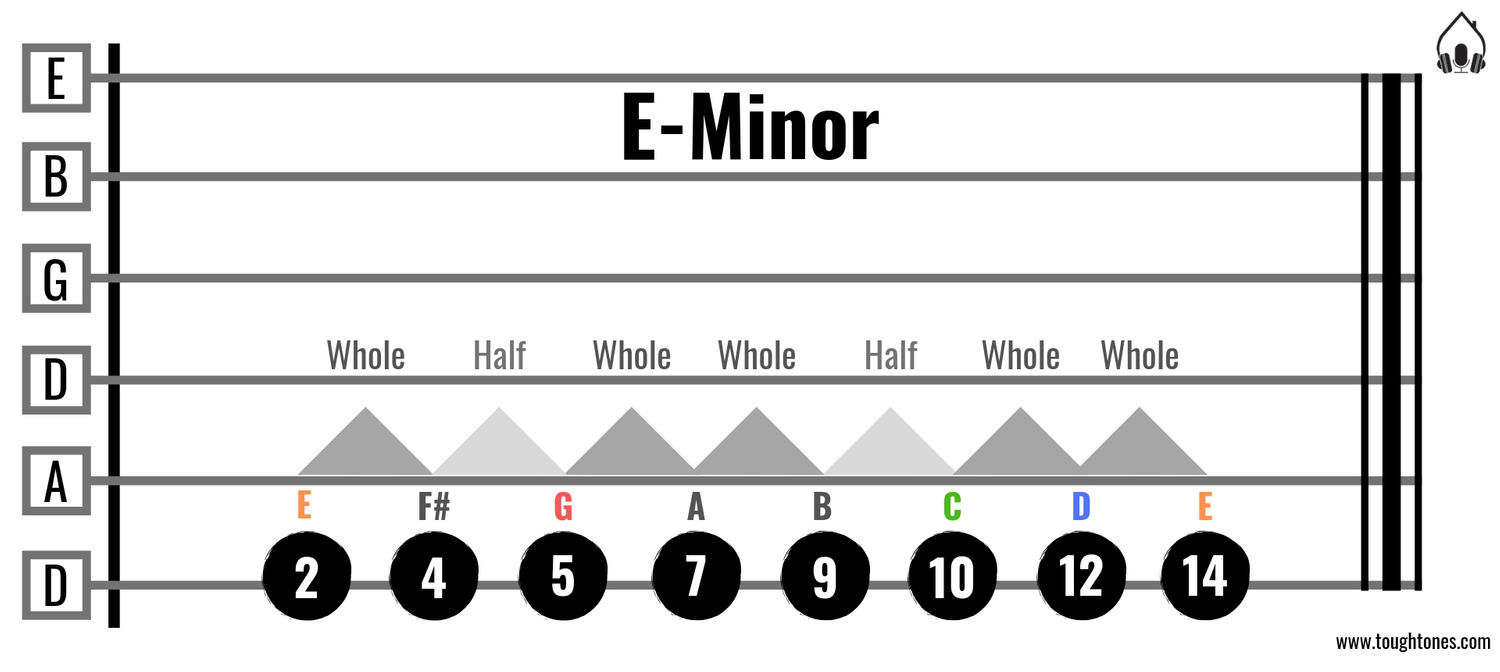
Now you know the notes, next you’ll form chords out of them. You can use the following pattern to know which ones are minors and which are majors: minor minor MAJOR minor minor MAJOR MAJOR. That gives us e-minor, f#-minor, G-MAJOR, a-minor, b-minor, C-MAJOR and D-MAJOR. Again, these are the same in all the different keys, the pattern doesn’t change.
You can expand that arsenal of chords with different E-minor scales, like harmonic e-minor, melodic e-minor and e-minor blues scale. The “extra notes” that these scales give you, are there for you to use as well.
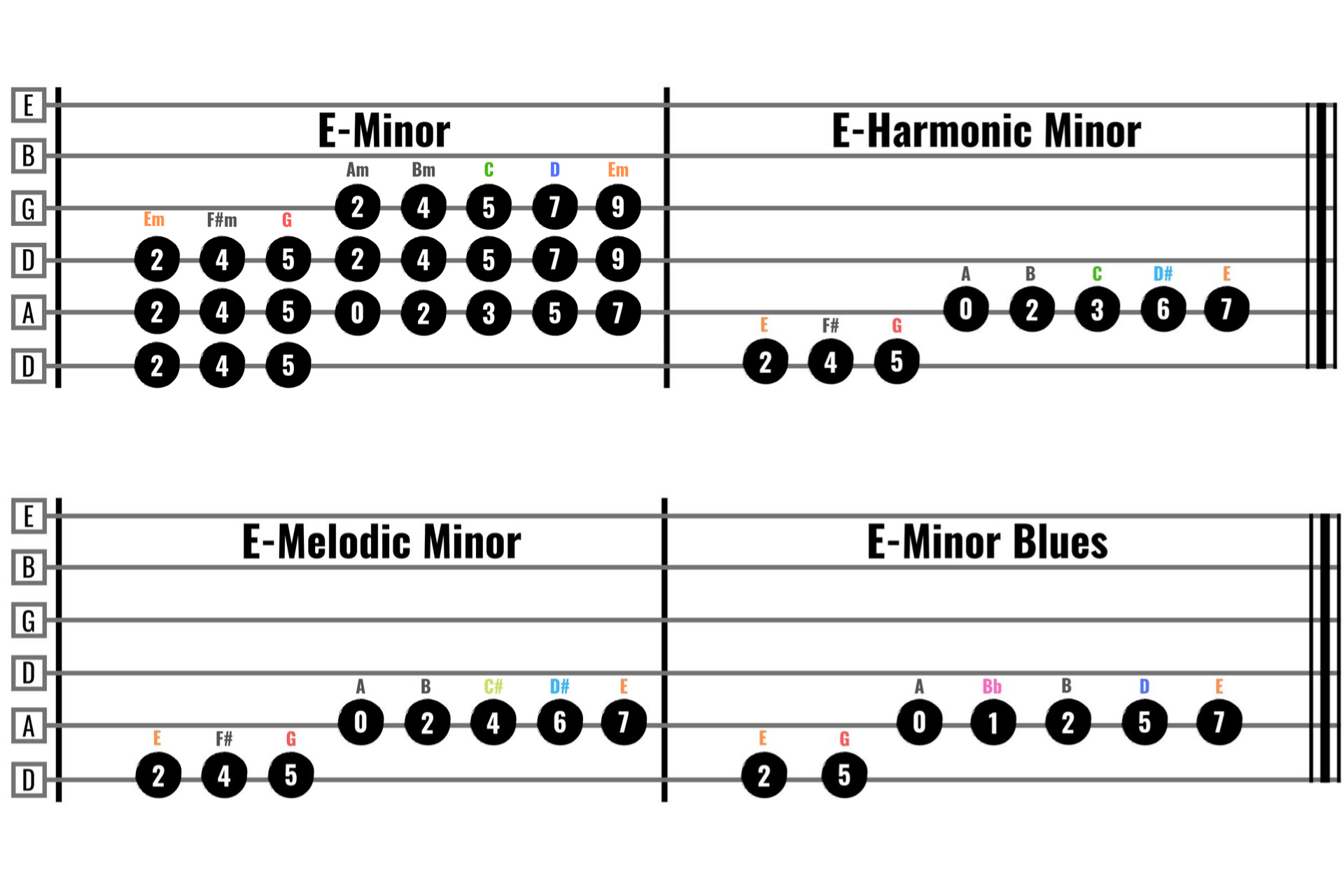
How will these “extra notes” from other scales help you to form new chords? These notes from other Em-scales – such as d# from E-harmonic minor – can be used to turn B-minor to a B-major for example. That’s a chord you can use in place of B-minor. B-major is not so sad, and has a huge pulling effect back to the first chord, whereas B-minor is really sad sounding and doesn’t pull back that much.
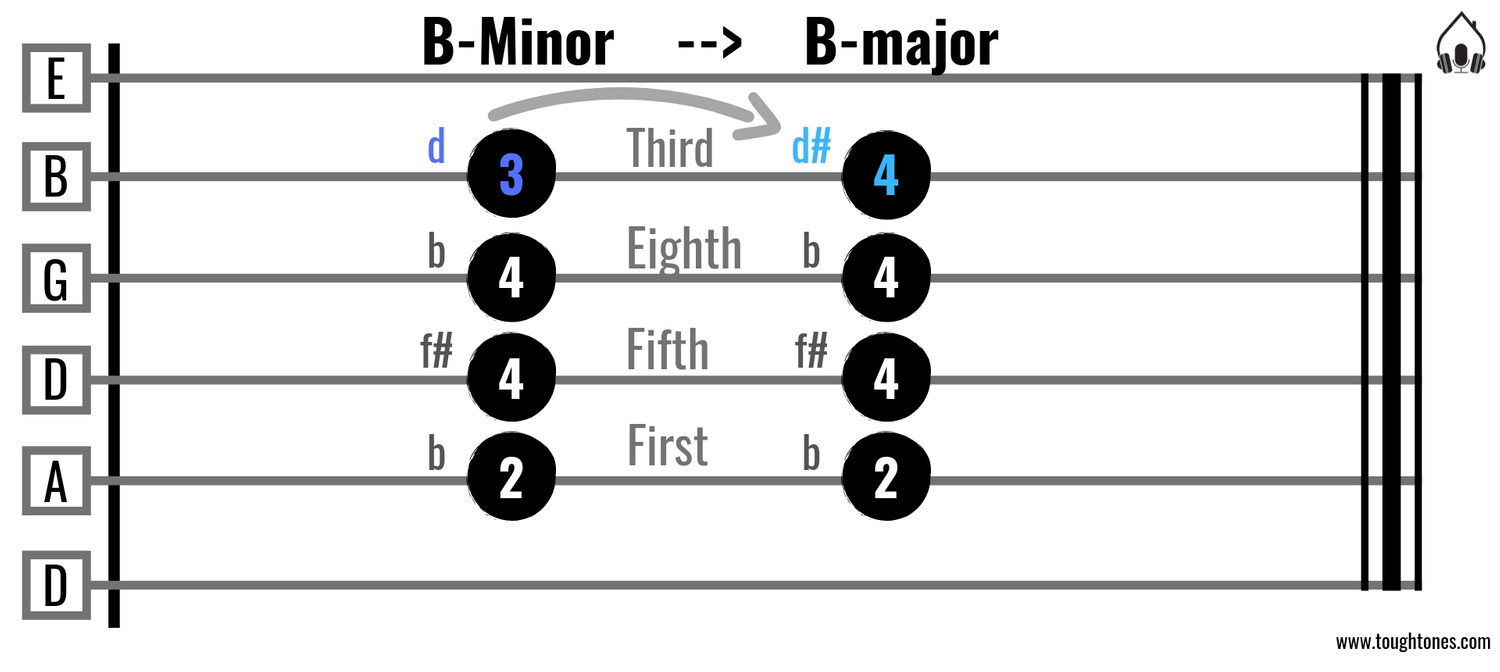
How to Form Chord Progressions?
How do you form chord progressions out of the chords and notes from the scales that you just learned? Let’s start with four bar progressions, where there’s one chord per bar. That gives us four chords. You don’t want to be making weird five or seven bar chord progressions at least until you’ve learned the basics.
Only Three Chords
The easiest way to start forming chord progressions is to use only these three chords: 1st, 6th and 7th, doesn’t matter what key you’re playing in. In E-minor 1st 6th and 7th chords would be Em, C and D. Start with either Em or C and the rest is up to you, there’s no other “rules”.
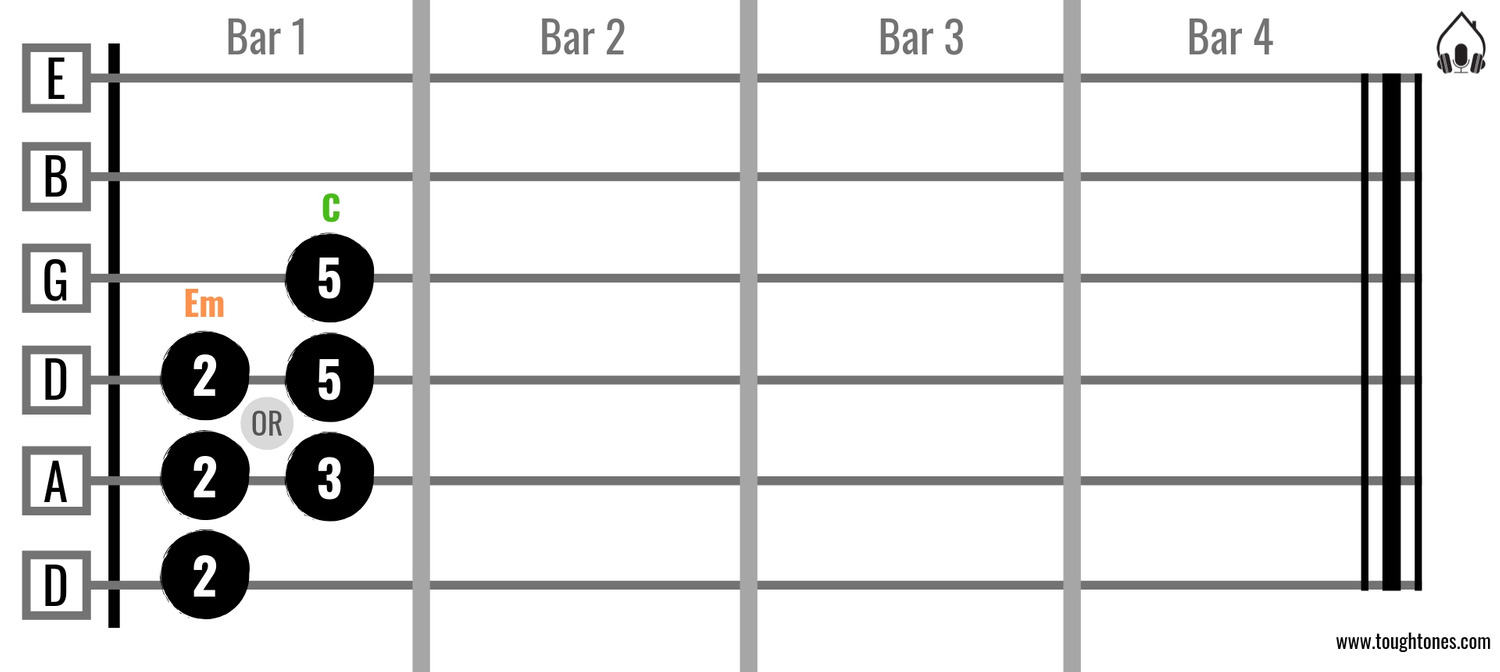
It will sound musical, no matter what combination you’re going for. You can do whatever works for your song and the mood that you’re going for. Let’s take a few examples. There’s a picture of the chord progression and underneath it you can listen to what it sounds like in context (with a whole band).
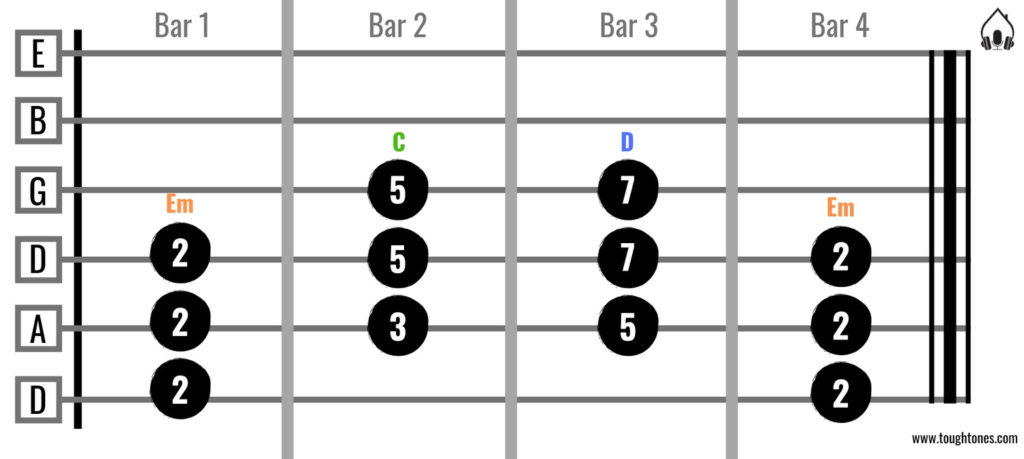
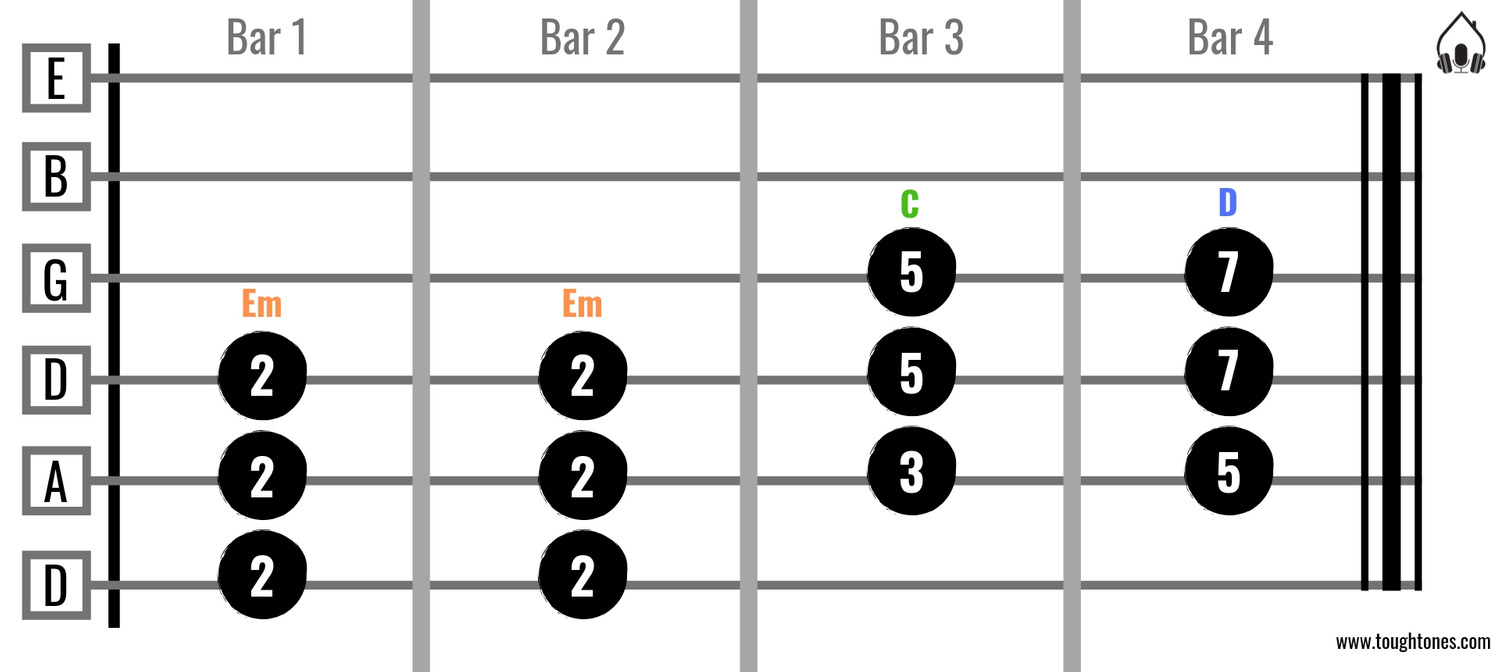
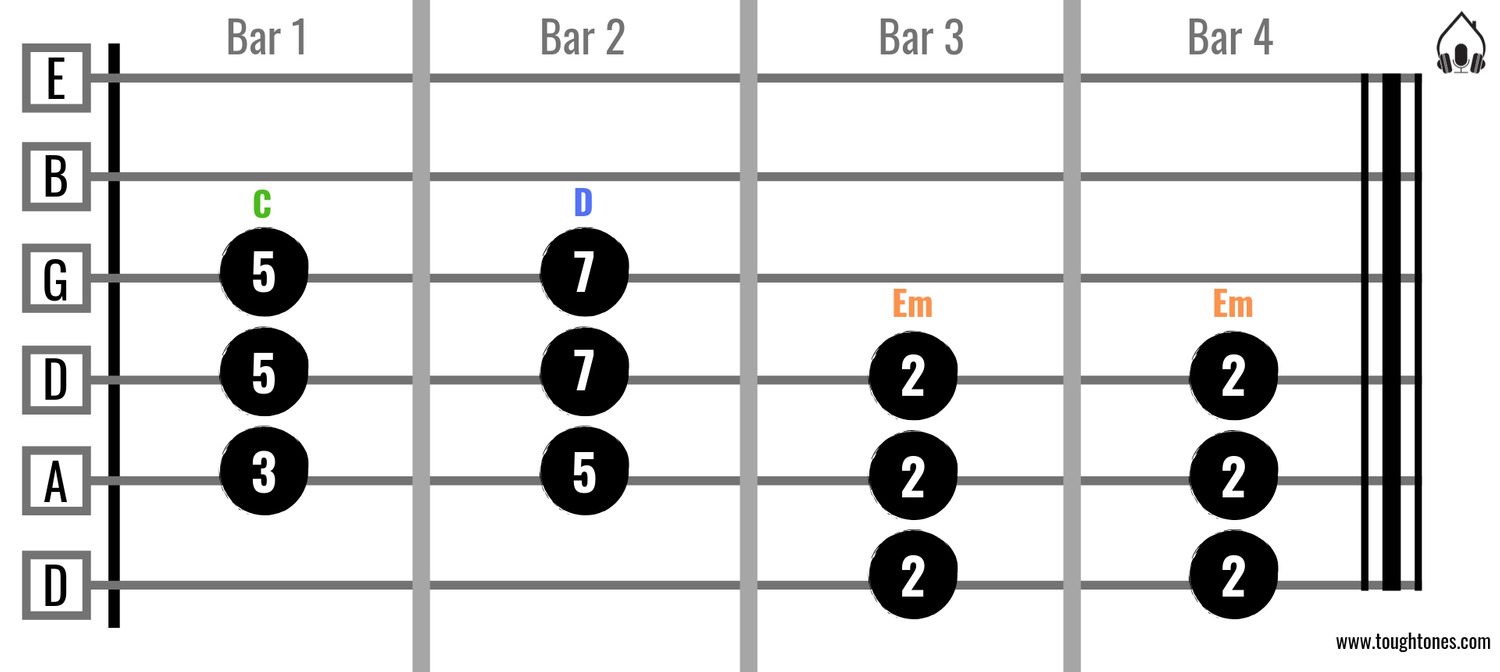
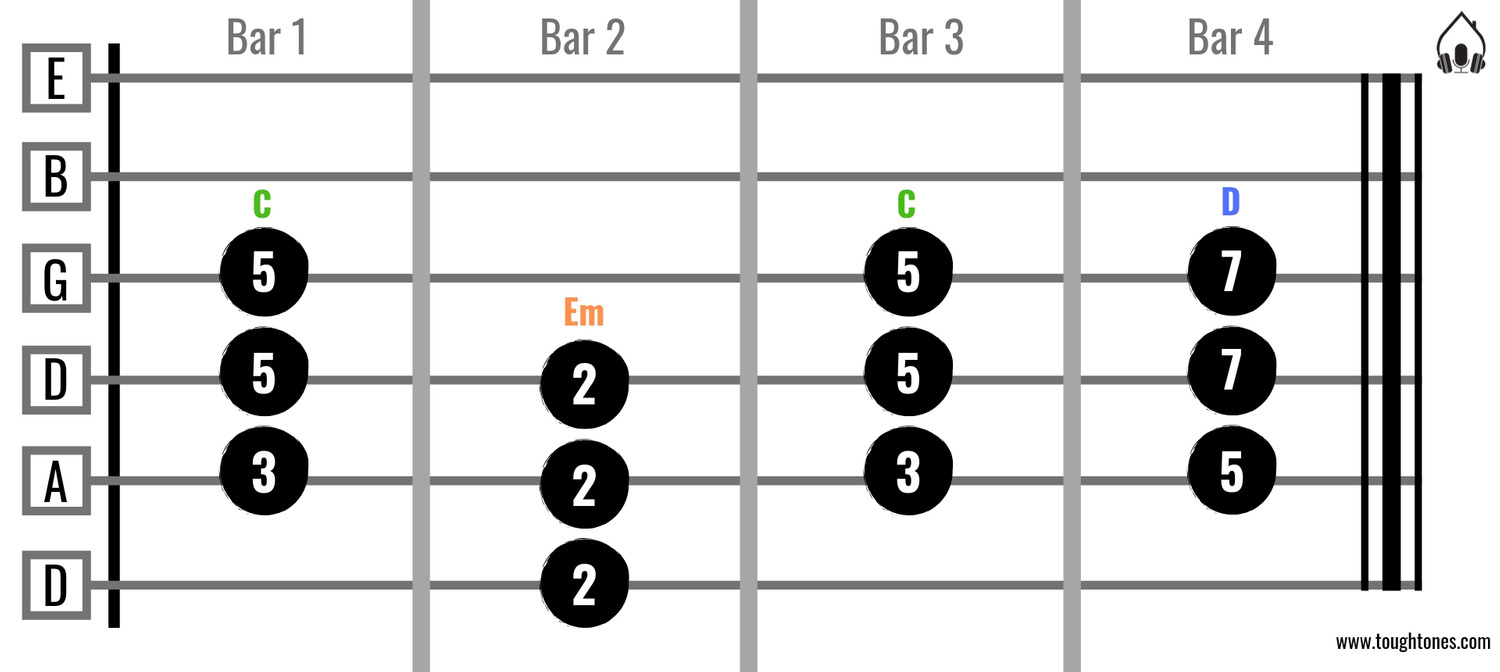
As you noticed, a lot of different kinds of moods can be created with just these three chords. How amazing is that?
Common Four Chord Progressions
Let’s add another chord to the mix – the third chord. In the key of E-minor that would be G-major. That’s the relative major to E-minor. It means that you can use the same chords with them, whether you’re writing in E-minor or G-major. Let’s stick with E-minor for now.
You can also start your chord progressions with the third chord, G, but it’s kind of like being in G-major, it makes the mood lighter. Of course it’s okay, if that’s what you’re going for. It’s a great way to add something interesting to your song. If you want to keep things simple at first, start with either Em or C and use the chord G elsewhere in your chord progression. Let’s take a few examples with these four chords.
Em C G D
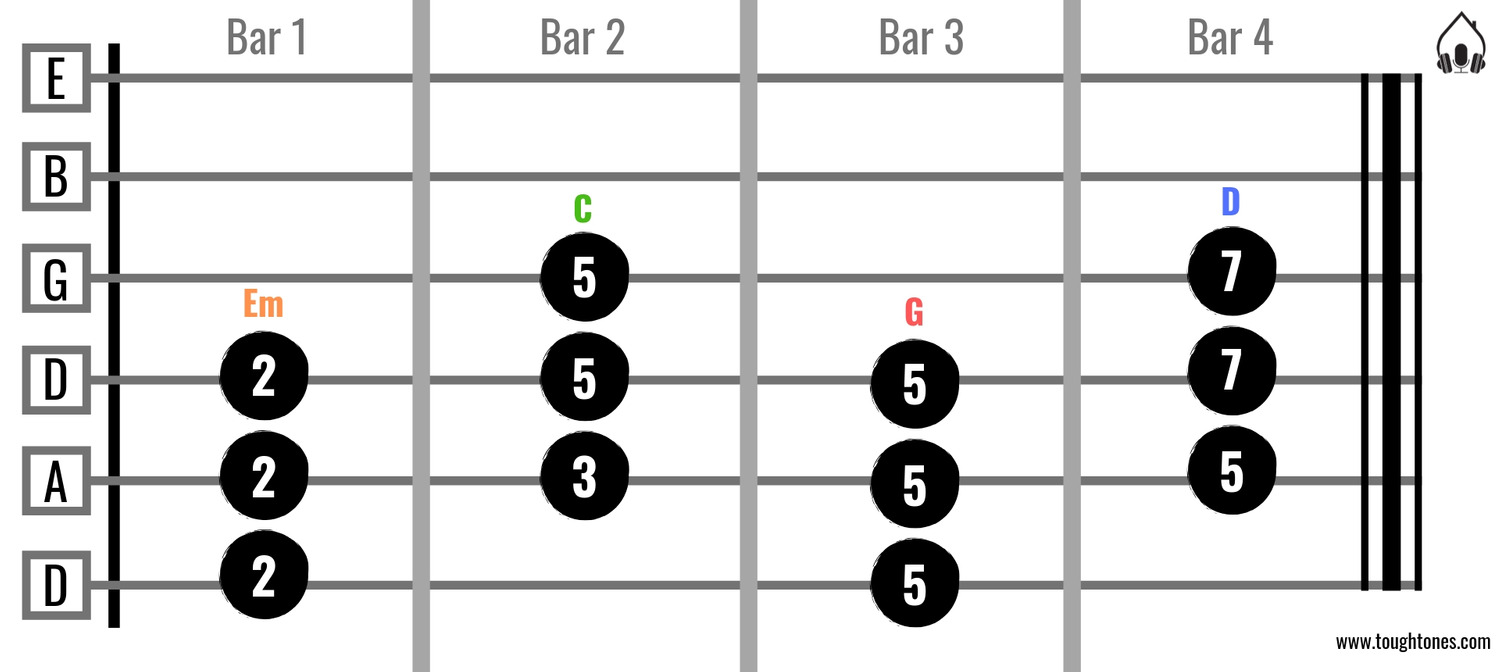
This one is really popular – the Em C G D. (Fun fact: Even if you try to google search for something else, like “Em G C D” Google asks “Did you mean “Em C G D?””. That’s gotta mean something.) For example Bring Me the Horizon – Drown is played with this chord progression throughout the song (Key C#m). You can also find it from the intro, verse and chorus of Linkin Park – Numb (Key F#m).
To give you an idea how popular this chord progression actually is, take a look at this list of songs that it’s featured in:
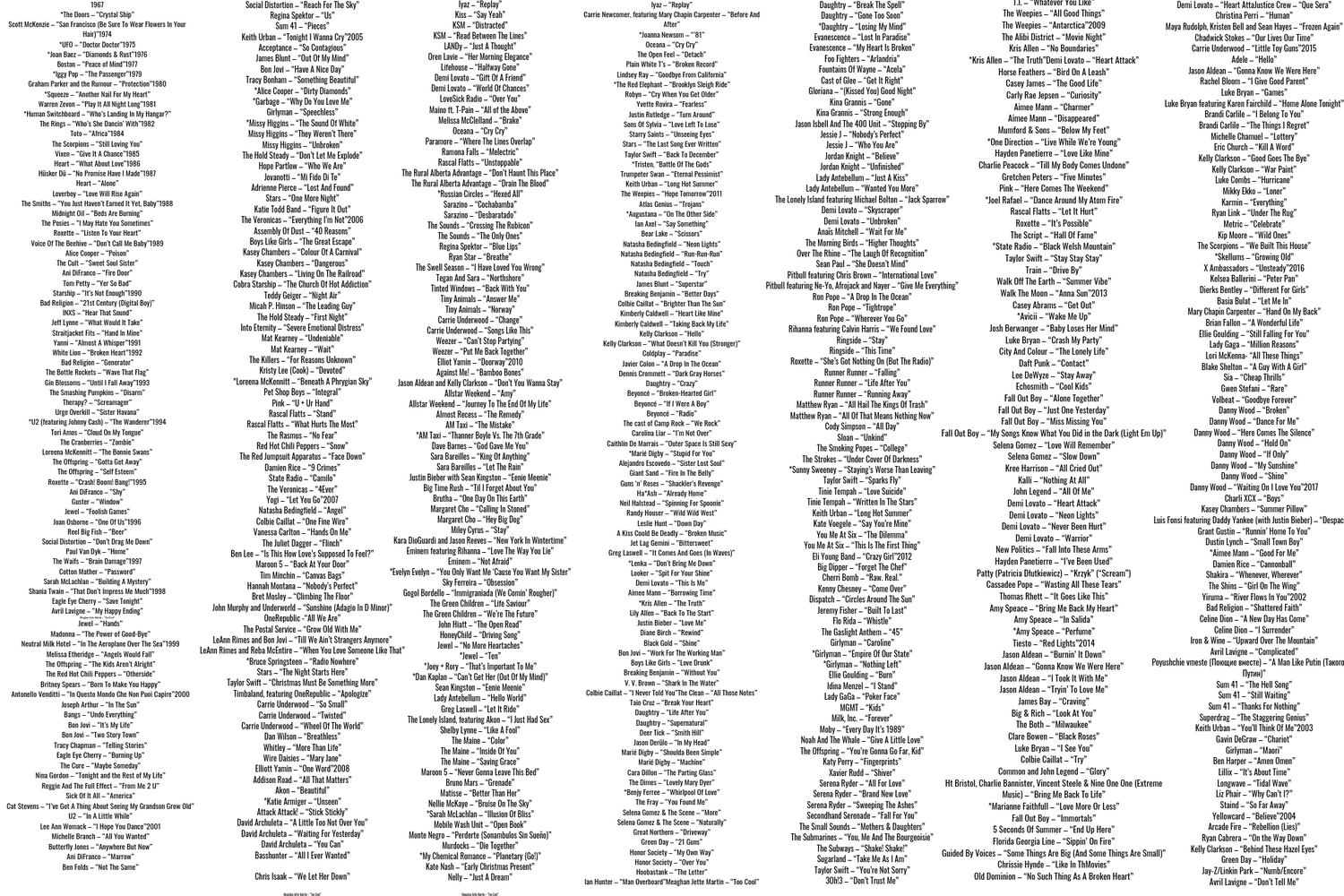
… Okay, here are some other chord progression examples:
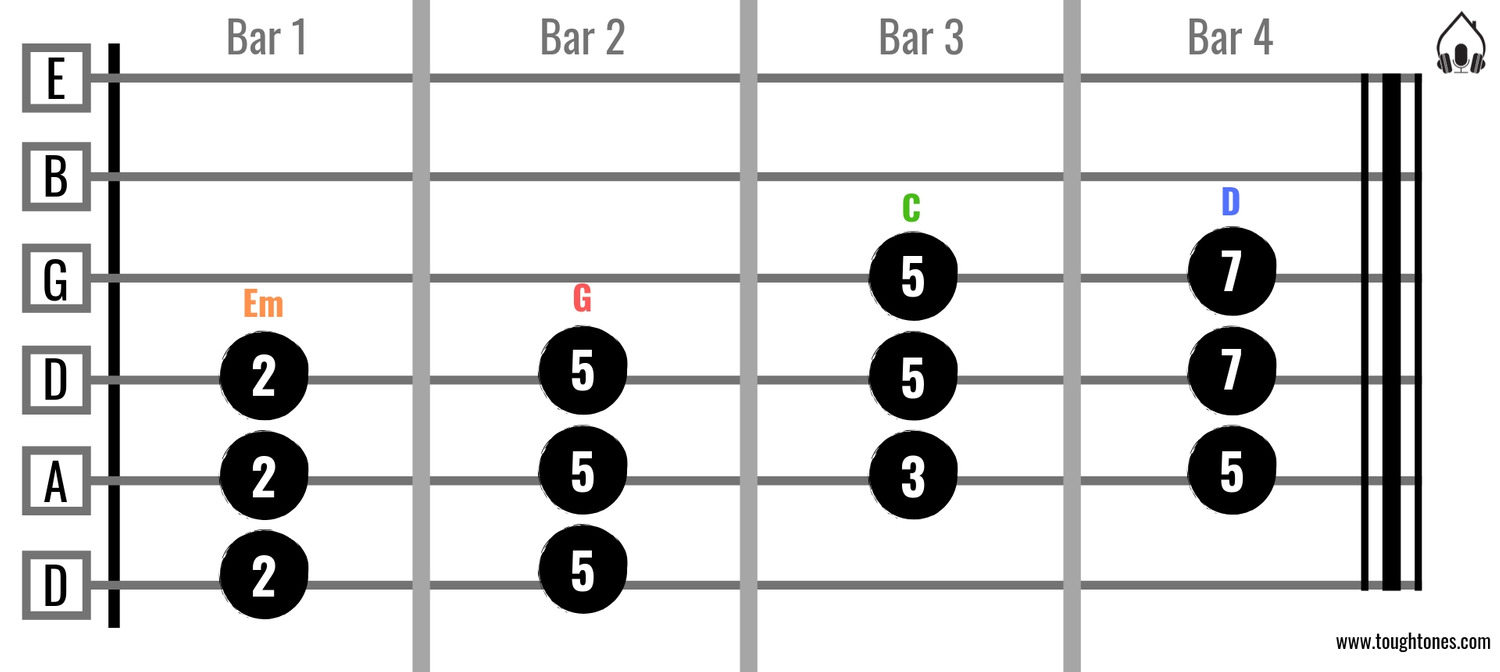
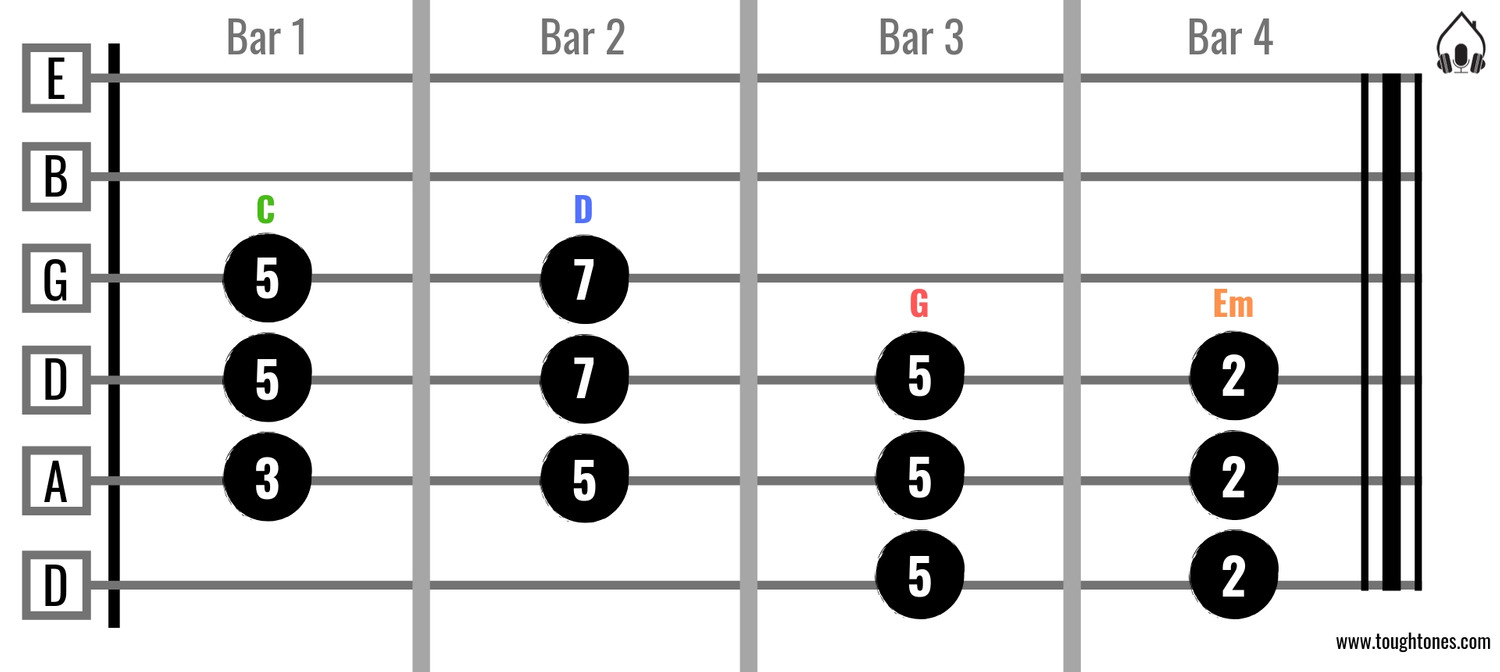
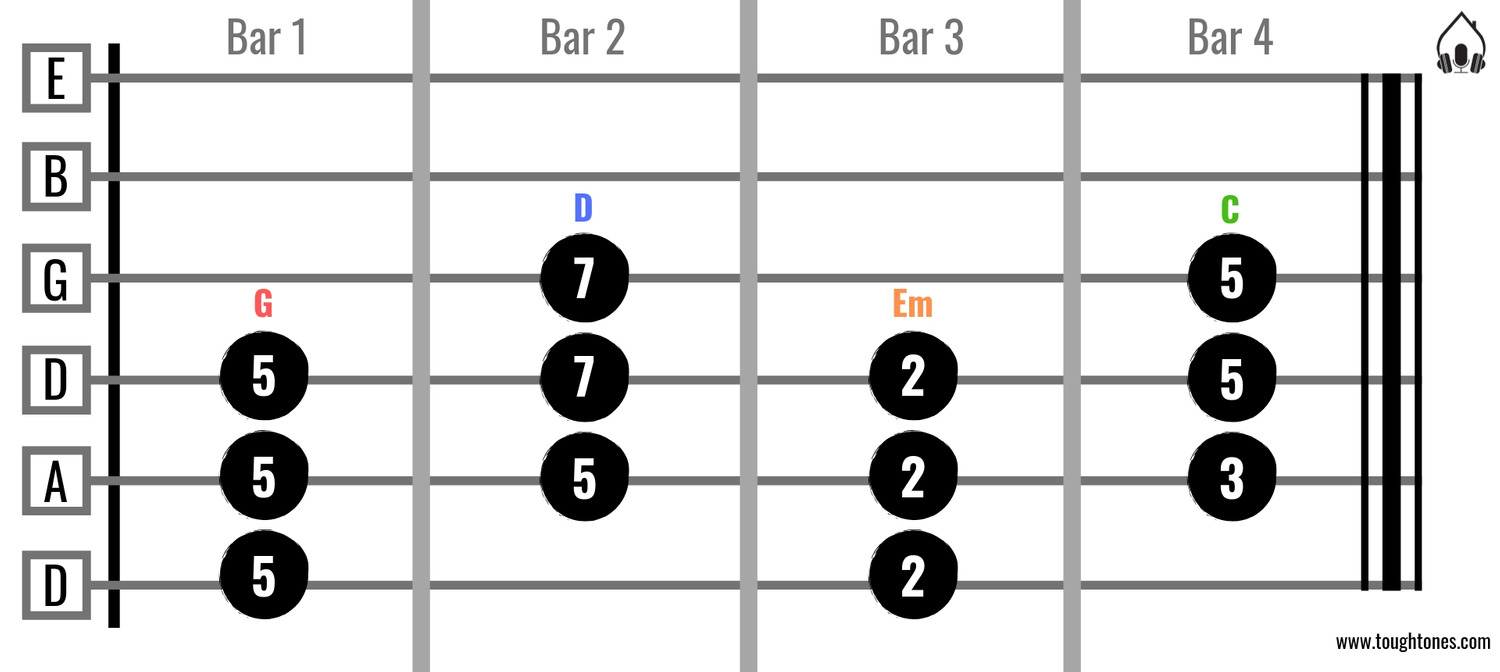
Adding the third chord (G) makes a chord progression less dark. It brightens up the mood a little bit. You could use this to your advantage in songwriting, for example by saving the G chord into the chorus and sticking with Em C and D in the verse, or the other way around. It’s one way to add contrast between verse and chorus.
Adding the Fourth and the Fifth Chord
It’s also possible to use the fourth and fifth chord in chord progressions. Those would be Am and Bm in E-minor key. Still, you want to start with either Em or C (or G). When it comes to the fourth chord, Am, it tends to work really well after G or D, but you can use it wherever you want. These are just examples of where I’ve found that it works well. Do what works for you.
The fifth chord, Bm, works just about anywhere. A popular way of using Bm is to make a rising or descending chord progression. Also like I mentioned earlier, you can turn Bm to B-major, if you take the extra note from e-harmonic minor. Using B instead of Bm gives you a really different kind of mood. Here are some examples of chord progressions that contain either the fourth or the fifth chord:
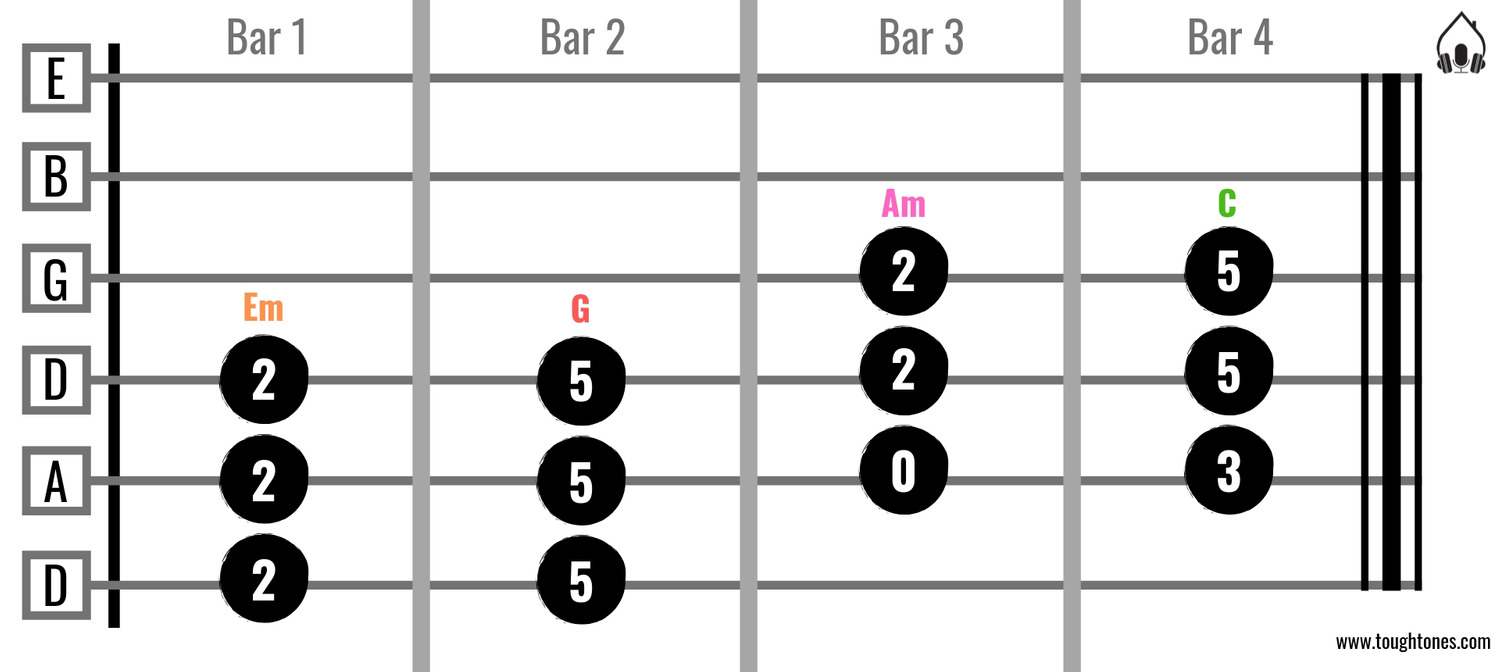
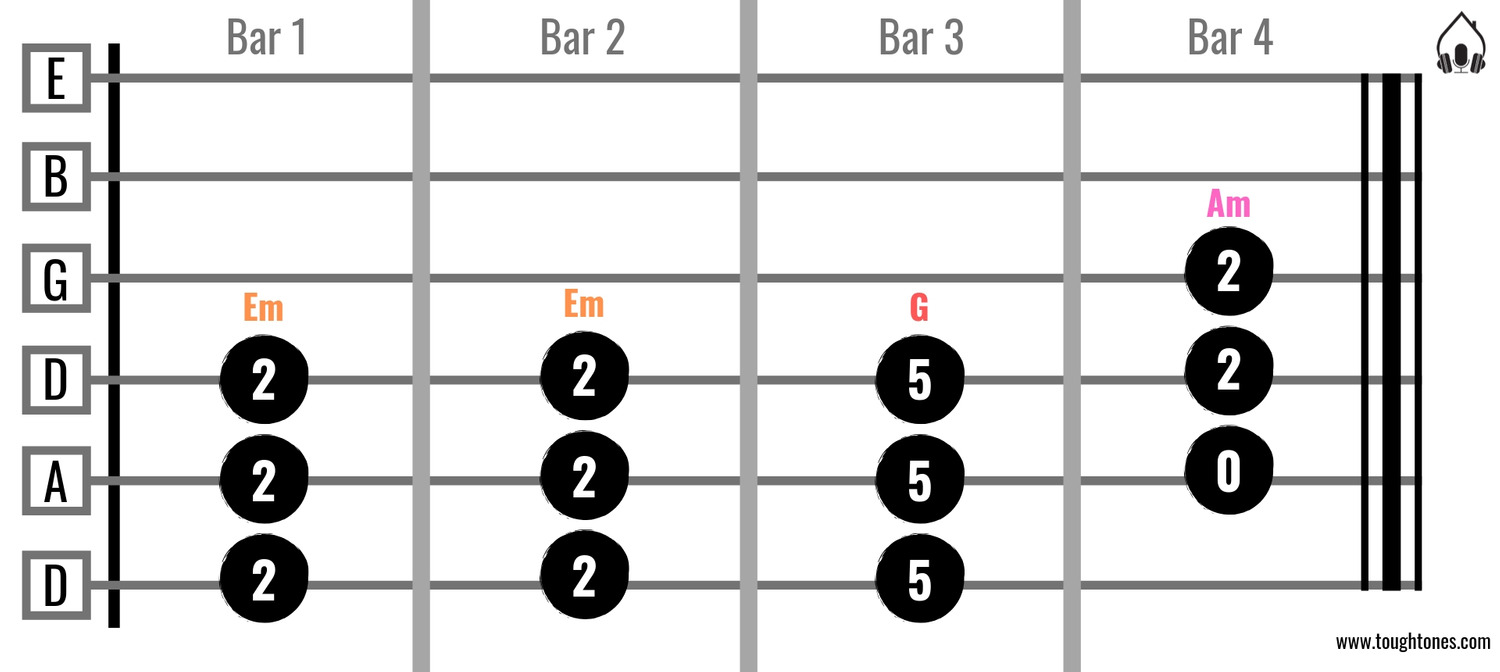
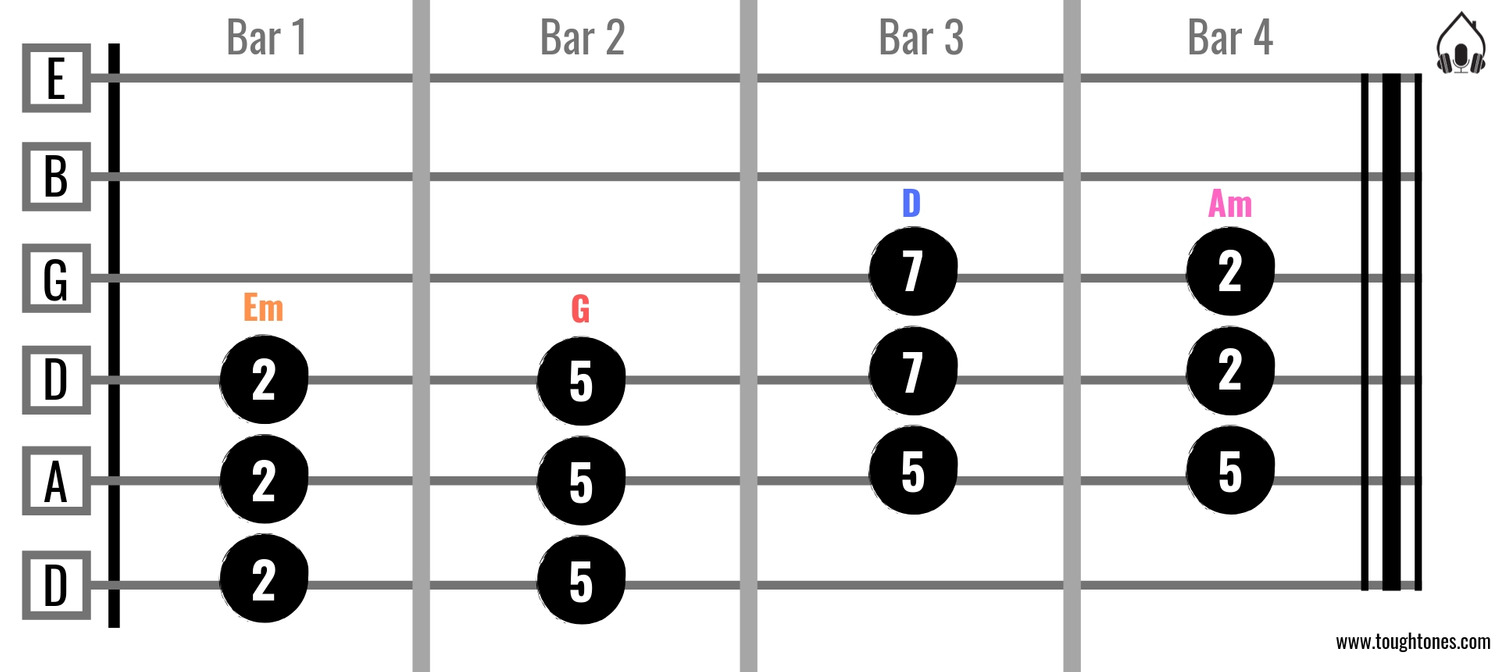
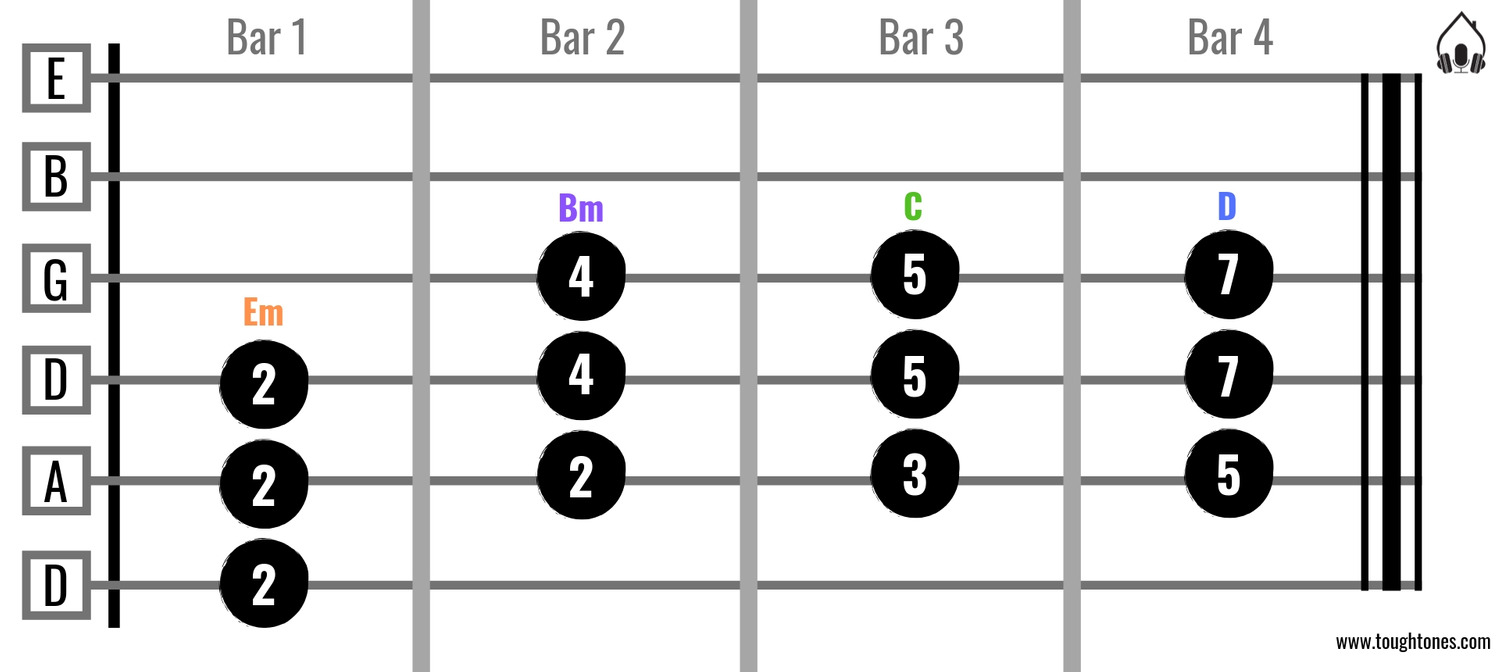
This is a chord progression that has a rising feel to it. For example Ed Sheeran – Don’t (Here’s a killer version of it btw: Blind Channel – Don’t)
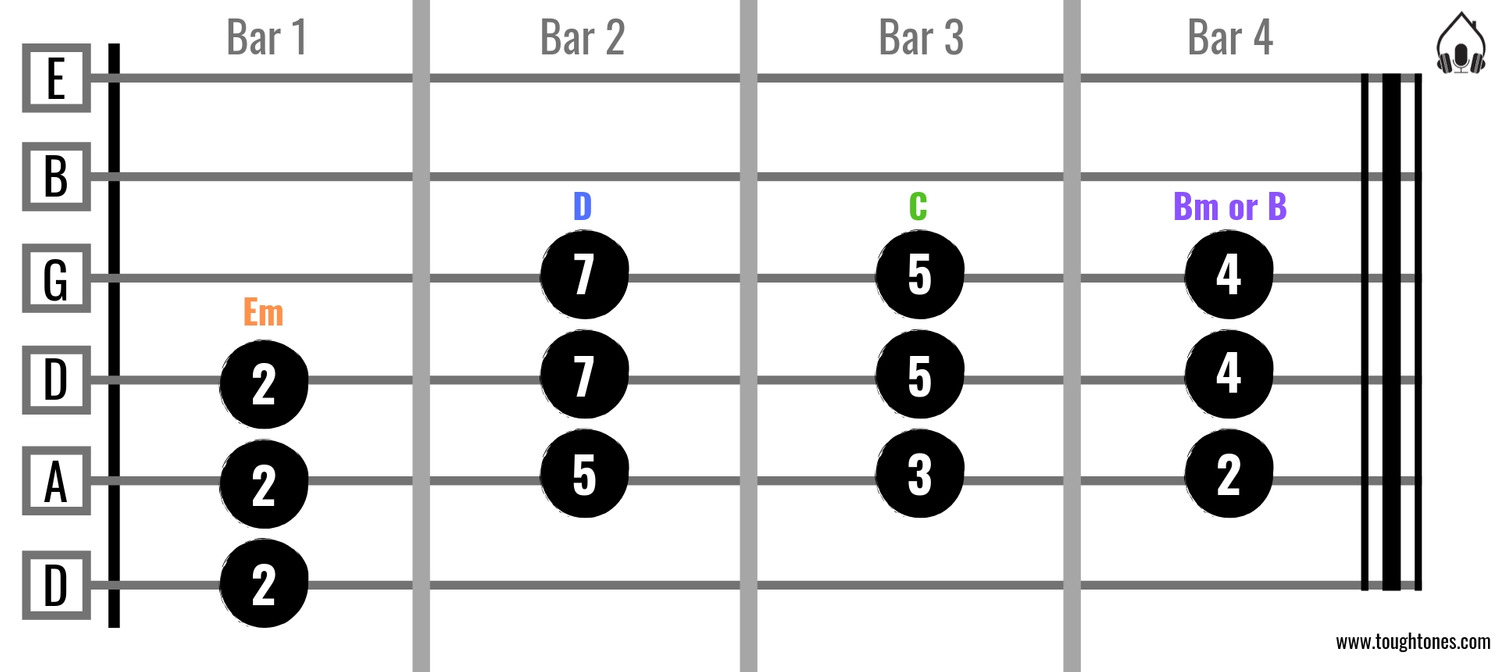
This is a chord progression that has a descending feel to it. A really popular example would be Dire Straits – Sultans of Swing (when the singing begins).
Last Words
That’s how you can approach making your own chord progressions when songwriting. Hopefully, you gained some knowledge on which chords might fit together. The examples I was using was just that, examples. They’re for you to be able to understand more easily how to form chord progressions. You can use whatever chords you see fit, as there are many many exceptions and stuff that music theory can’t quite explain.
I explained everything in E-minor, but you can form these progressions in any key. The chord patterns are the same. The distances between the first chord and the rest of the chords won’t change, they’re always the same. What changes is the key you’re in, the first chord from which you start counting on. See for yourself:
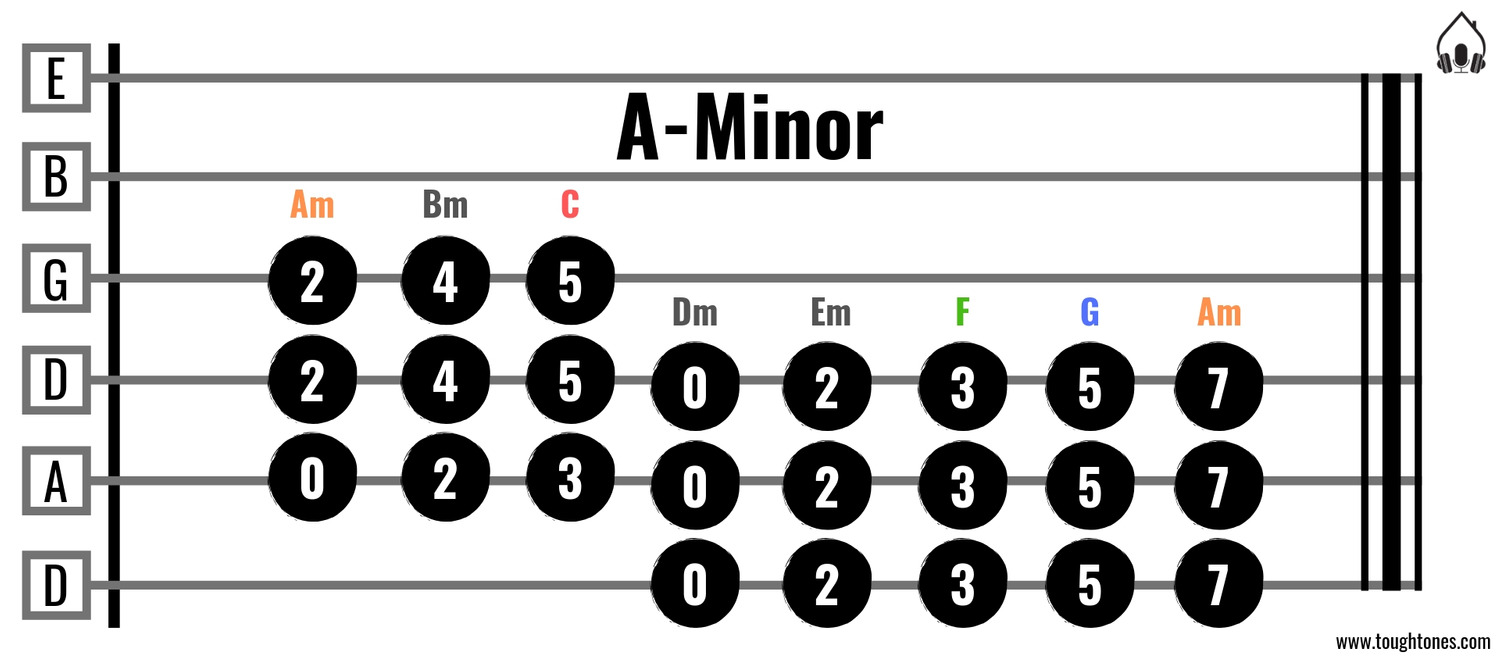
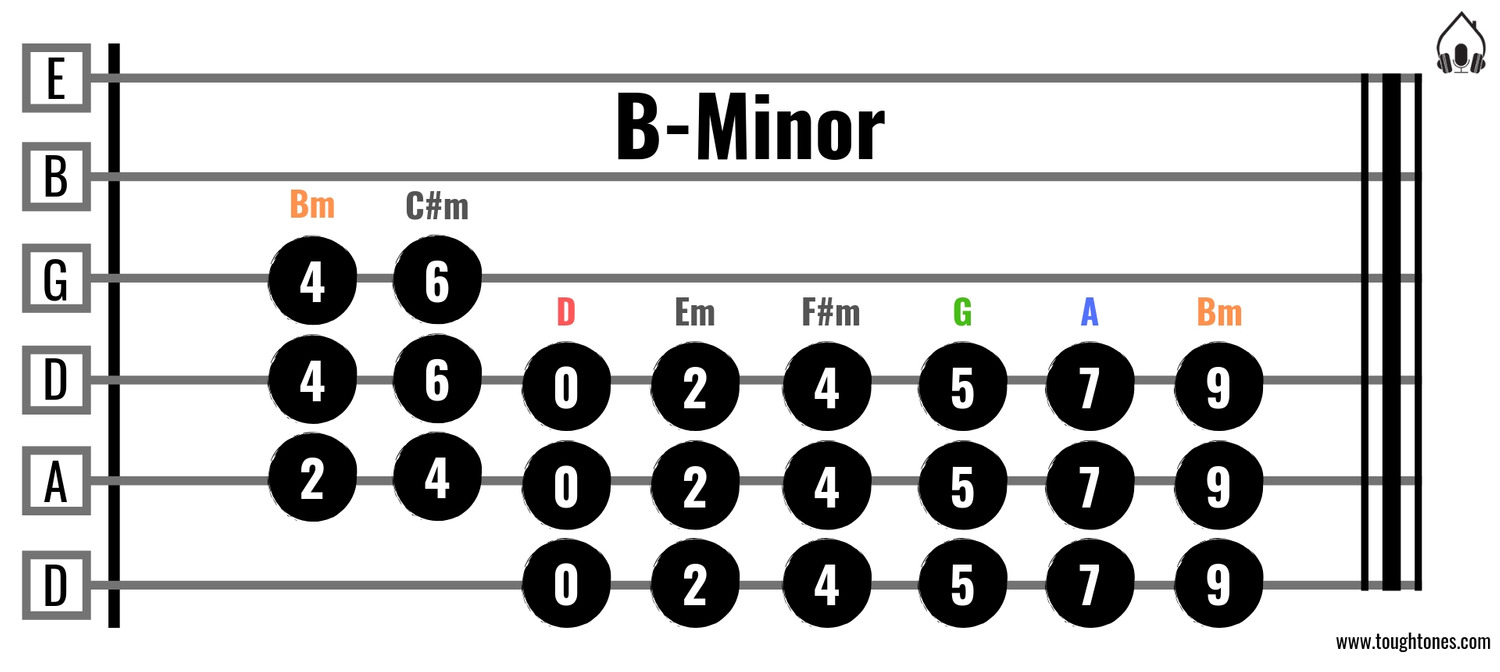
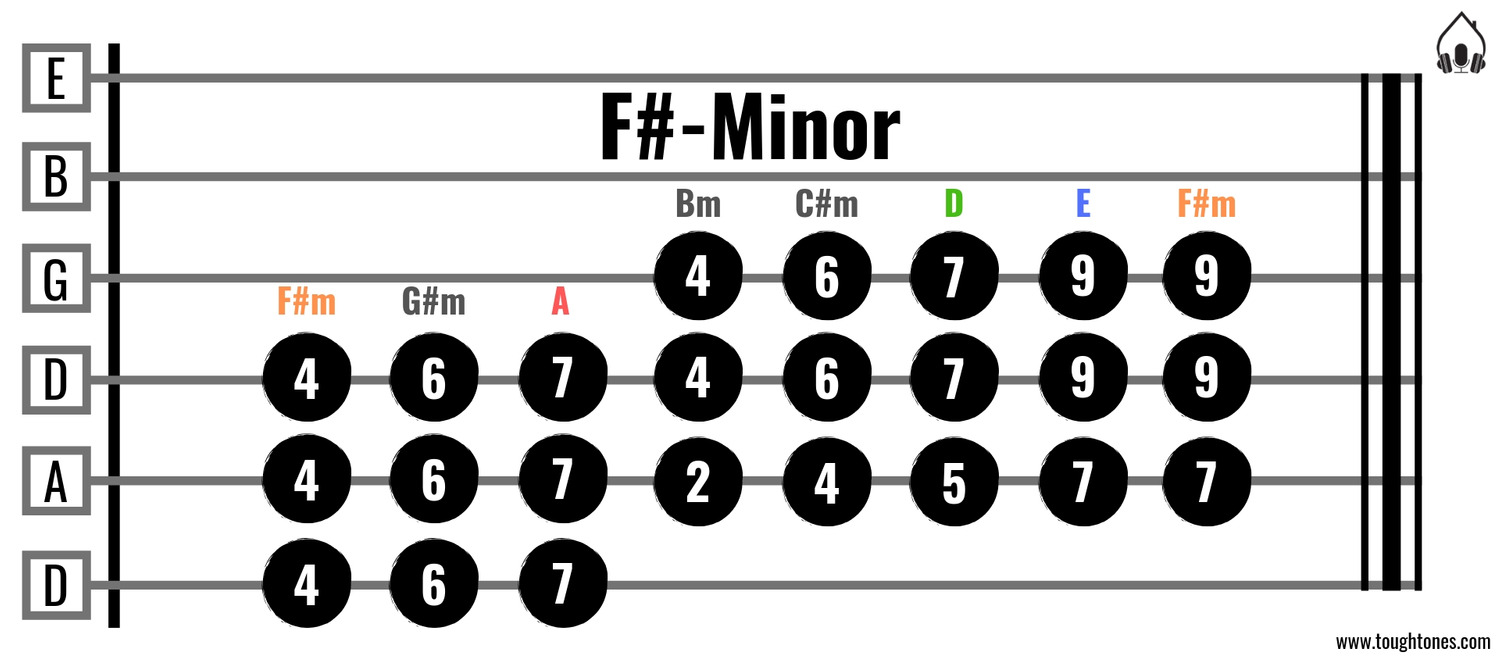
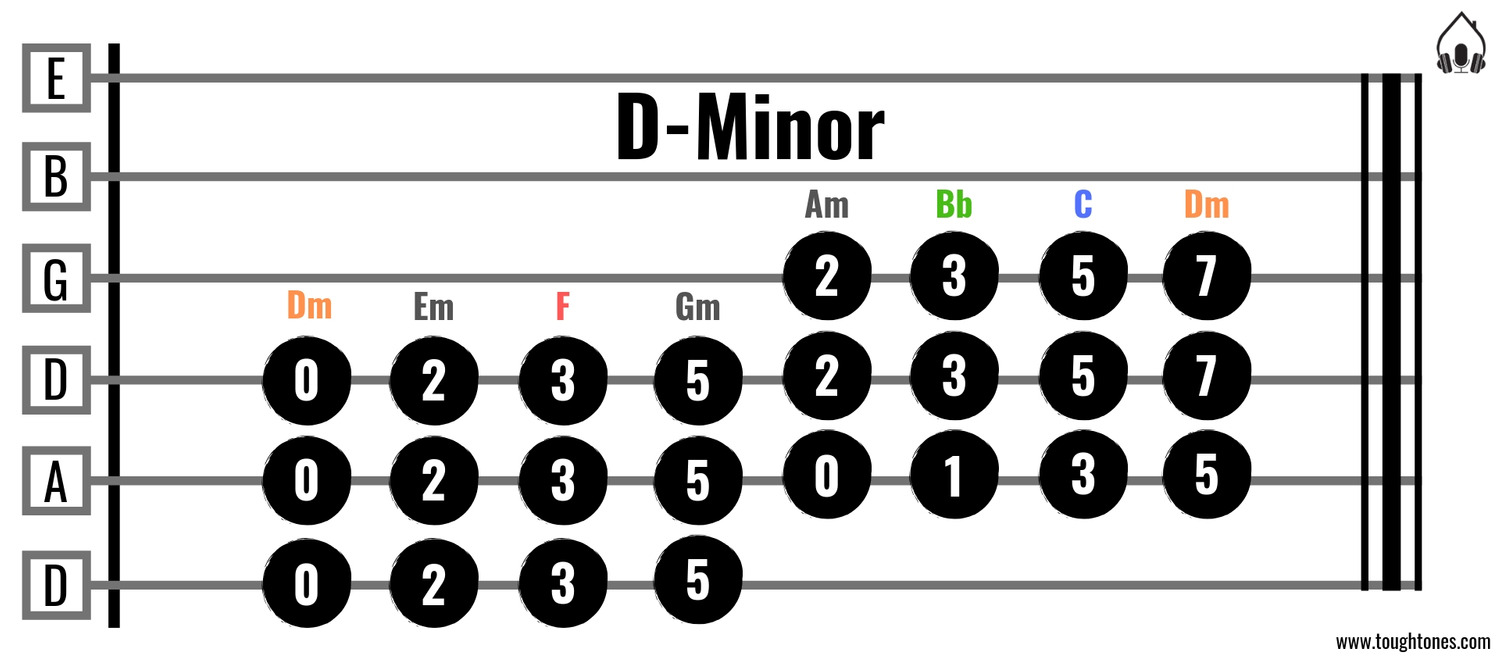
Do I Have to Use Only Four Chord Progressions?
Of course not. It’s just that usually in modern pop and rock music the chord progressions are either four or eight bars long. Within those bars, there can be faster or slower chord changes than one per bar.
It depends on the genre and the song (Sorry, I know it’s lame to say vague things like this, but it does). For example in progressive music there tends to be more complex bar counts and chord progressions.
Start with four and eight bar progressions. You can build on that as you become familiar with more easily approached progressions first. However, you don’t have to stick with just four chord patterns, as it might make your song sound static and loop-like.
You could also use eight bar progression. Don’t get me wrong, four bar chord progressions work beautifully, even if the same progression is used from start to finish. It’s all about what you’re looking for as a songwriter. Anyway, eight bar progression might be something like this:
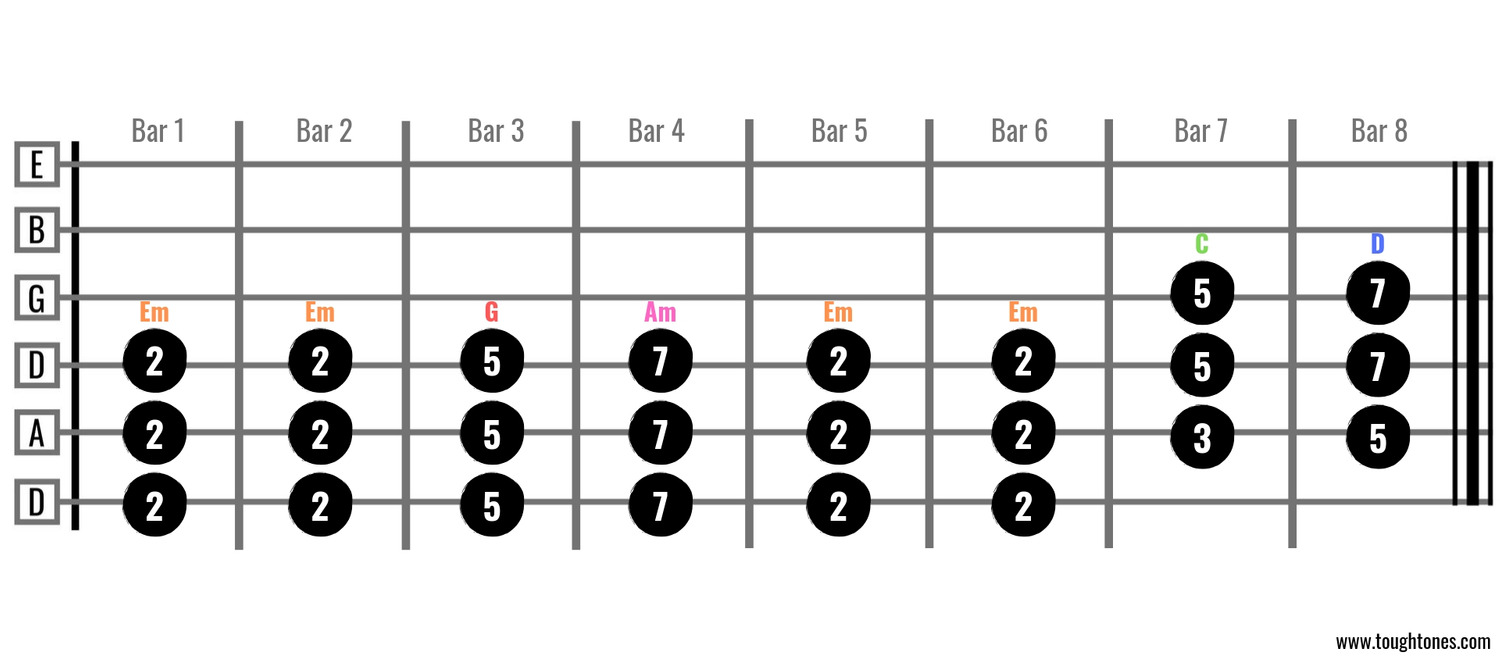
Or it might be something entirely different like this:
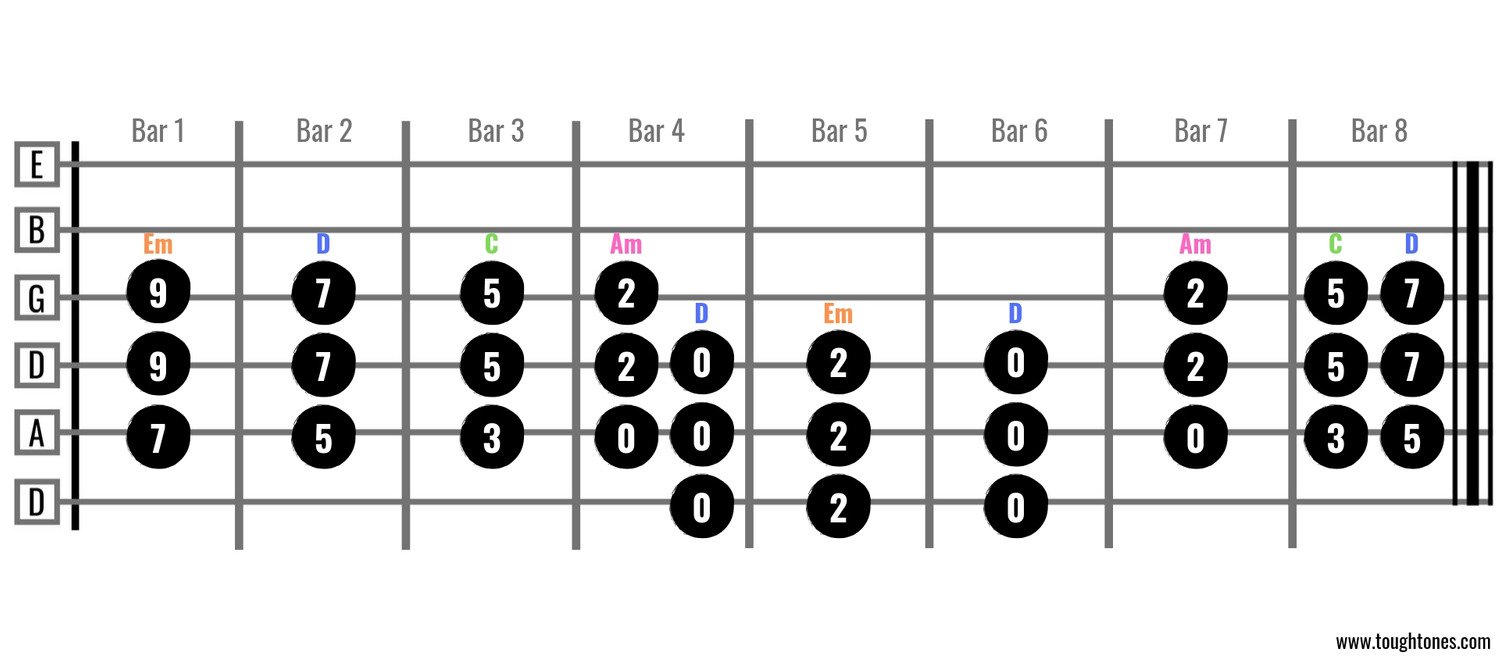
Summary
Thank you for sticking until the very end of this post. Here’s a short version of it: At first, use the three chords: the first (Em) the sixth (C) and the seventh (D). Then expand with the third chord (G). After mastering those four, start experimenting with the fourth (Am) and the fifth chord (Bm). Stick to four or eight bar progressions.
It’s easier to break patterns when you master them first. That’s why I want you to start with these simple steps. You can build on that later on, once the foundation is rock solid. Let me know if there’s something unclear. Leave a comment below or hit me up with an email.
Check also these useful guides to help you further with songwriting:
5 Steps to Create Music Faster (..and avoid the writer’s block!)
6 Step Guide to Realistic Midi Drums
You can get them for free today, no strings attached, enjoy!
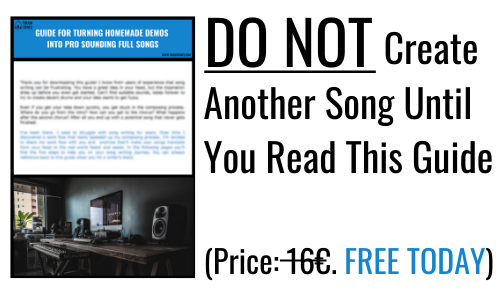
Thank you for another informative blog. Where else may
just I get that type of info written in such a perfect method?
I have a challenge that I am simply now working on, and
I’ve been on the glance out for such info.
Thanks , I’ve recently been searching for info approximately this subject for
a while and yours is the best I have discovered till now.
However, what about the conclusion? Are you certain concerning the source?